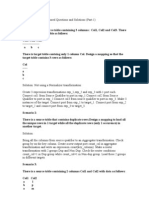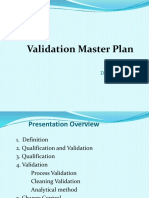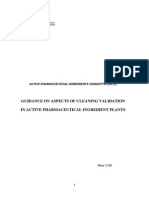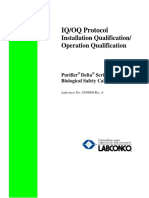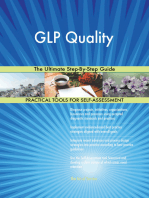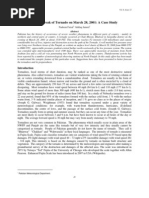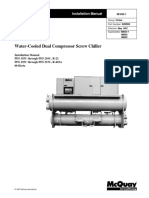100%(1)100% found this document useful (1 vote)
255 viewsEquipment Qualification
Equipment Qualification
Uploaded by
buuThis document outlines the stages of equipment qualification including defining user requirements, design qualification, factory acceptance testing, site acceptance testing, installation qualification, operational qualification, and performance qualification. It defines each stage and provides details on the objectives, components, and documentation required. The key stages are to ensure equipment is suitable for its intended use, is properly installed and operated, and can consistently perform as expected under real operating conditions over time.
Copyright:
© All Rights Reserved
Available Formats
Download as PDF, TXT or read online from Scribd
Equipment Qualification
Equipment Qualification
Uploaded by
buu100%(1)100% found this document useful (1 vote)
255 views64 pagesThis document outlines the stages of equipment qualification including defining user requirements, design qualification, factory acceptance testing, site acceptance testing, installation qualification, operational qualification, and performance qualification. It defines each stage and provides details on the objectives, components, and documentation required. The key stages are to ensure equipment is suitable for its intended use, is properly installed and operated, and can consistently perform as expected under real operating conditions over time.
Original Title
EQUIPMENT QUALIFICATION
Copyright
© © All Rights Reserved
Available Formats
PDF, TXT or read online from Scribd
Share this document
Did you find this document useful?
Is this content inappropriate?
This document outlines the stages of equipment qualification including defining user requirements, design qualification, factory acceptance testing, site acceptance testing, installation qualification, operational qualification, and performance qualification. It defines each stage and provides details on the objectives, components, and documentation required. The key stages are to ensure equipment is suitable for its intended use, is properly installed and operated, and can consistently perform as expected under real operating conditions over time.
Copyright:
© All Rights Reserved
Available Formats
Download as PDF, TXT or read online from Scribd
Download as pdf or txt
100%(1)100% found this document useful (1 vote)
255 views64 pagesEquipment Qualification
Equipment Qualification
Uploaded by
buuThis document outlines the stages of equipment qualification including defining user requirements, design qualification, factory acceptance testing, site acceptance testing, installation qualification, operational qualification, and performance qualification. It defines each stage and provides details on the objectives, components, and documentation required. The key stages are to ensure equipment is suitable for its intended use, is properly installed and operated, and can consistently perform as expected under real operating conditions over time.
Copyright:
© All Rights Reserved
Available Formats
Download as PDF, TXT or read online from Scribd
Download as pdf or txt
You are on page 1of 64
GMP: EQUIPMENT QUALIFICATION
& MAINTENANCE SYSTEM
TEGEGNE AKLILU: BSc, B Pharm, MSc.
MAR 2021
Outline
Introduction:
– Definition
– Stages of qualification
URS
DQ, FAT, SAT
IQ, OQ and PQ
Utility qualification: HVAC, WPU, Gases
Preventive maintenance
Introduction
• What is equipment qualification?
Equipment Qualification is the final series of
inspections and tests to ensure that critical
requirements (pre-determined specifications)
necessary for related product quality are
satisfied and that documents and procedures
necessary to properly operate and maintain the
system are in place.
• It is a team work/ job.
Introduction
Need of Qualification
• To manufacture a
quality product
• Proof “suitability for
intended use”
• Regulatory
requirements
• Cost effective
Introduction
• Different stages of equipment qualification:
– Defining User Requirements (URS) Defining
Functional Requirements for given User requirements
(FRS)
– Defining Design based on URS & FRS (DQ)
– Factory Acceptance Test at the site of manufacturer
(FAT)
– Site Acceptance Test at the site of user (SAT)
– Installation Qualification (IQ)
– Operational Qualification (OQ)
– Performance Qualification (PQ)
Introduction
• WHO: TRS 1019, 2019 annex 3
• Where appropriate, new systems, utilities and
equipment should pass through all stages of
qualification including the preparation of user
requirement specifications (URS), design
qualification (DQ), installation qualification
(IQ), operational qualification (OQ) and
performance qualification (PQ).
User Requirement Specifications (URS)
• An authorized document that defines the
requirements for use of the system,
equipment or utility in its intended production
environment.
• URS should be used to verify, at a later stage,
that the purchased and supplied equipment is
in accordance with the manufacturer’s needs
as specified.
User Requirement Specifications (URS)
• consist of Design Specifications and
Functional Specifications.
– Design Specifications provide explicit information
about the design requirements for equipment e.g.
the dimensions, material of construction, layout,
etc.
– Functional Specification denotes how each
feature of the equipment/ system must function.
User Requirement Specifications (URS)
• Technical specification (TS) describes how the
design requirements is translated into the
system and associated components.
• TS is prepared by the manufacturer and
submitted to the client for approval.
Design Qualification (DQ)
• Providing documented evidence that the
design of new equipment will result in a
system that is suitable for the intended
purpose.
– design and functional specifications for the
equipment, verified with the actual equipment
details (design and functional) offered by the
Supplier.
Factory Acceptance Test (FAT)
• A test conducted at the vendor’s premises to
verify that the system, equipment or utility, as
assembled or partially assembled, meets
expected specifications prior to shipment.
FAT includes:
– Checks for completeness of installation.
– Verification of URS with the actual.
– Proof of functionality, by either a conventional
function test or by simulation.
– Verification of documents (availability and quality).
– Overall Review/Inspection.
Factory Acceptance Test (FAT)
• The checks and tests during assembly or
partial assemble, should be recorded.
• The Panel wiring diagram (wiring inside the
control panel)will be prepared by the
manufacturer and verified by the client during
FAT.
• The acceptability of the assembly and overall
status of the equipment should be described
in a conclusion of the report.
Site Acceptance Test (SAT)
• When the system, utility or equipment is
received at the end user, tests should be
performed to verify the acceptability of the
system, utility or equipment.
• The results of the tests should be recorded
and the outcome of the acceptability of the
equipment recorded in the conclusion of the
report for the site acceptance test (SAT).
Installation Qualification (IQ)
• The performance of tests to ensure that the
installations (such as machines, measuring
devices, utilities and manufacturing areas)
used in a manufacturing process are
appropriately selected and correctly installed
and operate in accordance with established
specifications.
Installation Qualification (IQ)
IQ Protocol/ plan
• A document describing the activities to be
performed in a validation.
• As a minimum the protocols should include
the following significant background
information:
Installation Qualification (IQ)
Protocol contents:
• the title and objective,
• Site of the study,
• equipment name and unique identification
number
• model and serial number
• details of the supplier and manufacturer,,,
• date of installation,
• components and their identification numbers or
codes, etc…
Installation Qualification (IQ)
• IQ should include identification and
verification of all system elements, parts,
controls, gauges and other components.
• Measuring and indicating devices being
installed should be calibrated. [Certificates
traceable to relevant national or
international standards should be available]
• Also welding documentation.
IQ test consist of checking of:
Presence of all components of the equipment against the
specification described in Design Qualification and/ or
manufacturers’ specification.
Damages to the component.
Design features of all critical component e.g. dimension, make,
model, Material of Construction etc. against the DQ specification
and/ or manufacturer’s claim.
List of Instruments requiring qualification
Utility connection against applicable specification.
Availability of required documents i.e. instruction manual,
drawings etc.
Verification of drawings, correct markings
Assembly of components against the manufacturer’s
recommendation
List of spare parts
Installation Qualification (IQ)
• any CGMP requirements relevant to the IQ—
and the methodology used for IQ—must be
documented thoroughly in the Validation
Master Plan (VMP).
Installation Qualification (IQ)
• Installation Qualification to be re-qualified
through change management:
1. Shifting of the equipment from one location to
another(excluding portable type).
2. In case of major modification or to address the
qualification of newly added component
• IQ is to be executed typically against a pre-
approved protocol, and all the results are to
be compiled and summarized.
Operation Qualification (OQ)
• Documented verification that the system or
subsystem performs/operates as intended
over all anticipated operating ranges.
• Once the results of the IQ execution have
been reviewed and approved, the OQ
execution can begin.
Operation Qualification (OQ)
• OQ specifically tests each function of the system
e.g., unit operational functions, specific
equipment functional testing, etc.
• To ensure that the intended tasks will be
performed when the equipment is adjusted and
operated throughout the recommended
operating ranges.
• The OQ execution process provides an
assessment of the system operation.
• The OQ phase includes calibration/testing of the
instruments.
Operation Qualification (OQ)
• During OQ, if any calibration activities are
undertaken by an external agency, the
calibration reports of such activity should be
reviewed by site representative for
compliance to laid down specifications.
• It shall be part of calibration data and
qualification report.
Operation Qualification (OQ)
• The title and objective
• Scope
• List of calibration equipment required
• Visual inspection of individual systems for leak
• Verification of HMI screens
• Functional check of PLC
• Operation of pumps
Operation Qualification (OQ)
• Operational verification tests in different
operation ranges
• Alarm check of PLC control panel
• Attachments– calibration certificates, SOPs,
training records, ….
• Output reports
Operation Qualification (OQ)
• A draft Standard Operating Procedure for
operation & preventive maintenance
(wherever applicable) of the equipment,
instrument & system is prepared during the
Operational Qualification.
• Training of operators for the systems, utilities
and equipment should be provided and
training records maintained.
• released for PQ or routine use after
completion of OQ.
Operation Qualification (OQ)
• All calibration, cleaning, maintenance,
training and related tests and results should
be verified to be acceptable.
• Any discrepancy or deviation should be
recorded and investigated.
• The outcome of the OQ should be recorded in
the conclusion of the report.
Operation Qualification (OQ)
• Operational Qualification to be re-qualified in
case of:
1. Shifting of the equipment from one location to
another (excluding portable type).
2. In case of major modification or to address the
qualification of newly added component RQ be
initiated (RQ is referred in a separate section).
• OQ is executed against a pre-approved protocol,
and all the results are to be compiled and
summarized.
Performance qualification (PQ)
• Documented verification that the equipment
or system operates consistently and gives
reproducibility within defined specifications
and parameters for prolonged periods.
(In the context of systems, the term “process
validation” may also be used.)
• PQ is the final stage of qualification demonstrates
how equipment will perform at actual production or
operating conditions.
Performance qualification (PQ)
• There should be records for the PQ (report) to
indicate the satisfactory performance over a
period of time.
– Manufacturers should justify the selected period
over which PQ is done.
• PQ should be done once OQ is successfully
completed.
Performance qualification (PQ)
• The PQ integrates procedures, personnel,
systems, and materials to verify that the
pharmaceutical grade utility, environment,
equipment, or support system produces the
required output.
Pre-requisites to PQ execution are:
• Availability of approved OQ Report
• Availability of effective SOPs for operation,
calibration, cleaning, maintenance of the said
equipment
• Training of relevant personnel
• Updating of Calibration & PM Schedules
• Completion of PLC Validation
• Training on GDP for external vendor, if vendor is
executing the protocol
Performance qualification (PQ)
• Acceptance criteria should be clearly indicated
within the PQ document.
• Samples are collected (as defined sample plan)
to check the quality of the produced product
by the equipment.
• Compile the collected data and aggregate the
obtained data in laboratory,
• Report deviations of performance qualification
document any discrepancy
Performance qualification (PQ)
• Performance Qualification to be re-qualified in
case of:
1. Replacement of existing instrument / component in
the equipment with a new one, which can have a
direct impact on the performance of the equipment.
2. Any major modification to the existing
Equipment/System, which can affect the
performance of the equipment.
3. If system is found to be malfunctioning during
performance qualification.
Verifies
Re-Qualification
• Re-Qualification is an activity involving
complete or portions of ‘elements’ of
qualification activities, like IQ, OQ and PQ
• “Systems, utilities and equipment should be
maintained in a qualified state through the
life of the system, utility or equipment”
– Periodic/ Routine as per the schedule in the VMP,
which is based on the outcome of risk
management principles.
Re-Qualification
Other Various reasons:
• To address deficiencies observed in an executed qualification
• Need for additions in qualification test criteria
• To qualify changes done in the equipment or a process
involving the equipment
• Failure
• CAPA
• Findings/ Recommendations from Inspections/ Audits/ PQR,
etc.
• Inputs from Preventive Maintenance/ Calibration Program
• Equipment Up-gradation
Notes for Legacy Equipment
• In case a utility or equipment in use (legacy
equipment) is identified that has not been
subjected to qualification, a qualification
protocol should be prepared where elements
of URS, design specifications, operation and
performance are verified for acceptability.
• The outcome of this qualification should be
recorded in a report.
Validation Master Plan
• Site qualification and validation programme
should be clearly defined and documented in a
validation master plan (VMP) (PIC/S GMP PE009-
14, 2018 - Annex 15)
• Covers manufacturer’s validation policy and
needs
Validation Master Plan
• Provides information on validation organization
• It should describe:
• why? Philosophy
• what? Equipment, Utility, …
• where? Location
• Whom? Responsible departments/ Persons
• How? SOPs and Protocols
• When? Planning and scheduling.
VMP should contain at least:
• Qualification & Validation policy (including risk
assessment requirement)
• Organizational structure & personnel responsibilities
• Summary of facilities, systems, equipment, processes
to be qualified/validated
• Documentation format for protocols and reports
• Cross references to documents
• Planning and scheduling
• Change control and deviation management
• Training requirements
• Qualification and validation strategy for requalification,
where applicable.
Utility Qualification
Utility Qualification
• Critical utilities like Water (PW, WFI),
Compressed Air, Nitrogen, Air Handling Units
(AHU) and HVAC systems support the
manufacturing process.
• Similar stages of qualifications are followed to
ensure that utilities in use conform to health
and safety regulations as well as
pharmaceutical manufacturing standards and
cGMP guidelines.
Qualification of HVAC system
• Stages of the qualification of the HVAC system
include design qualification (DQ), installation
qualification (IQ), operational qualification
(OQ), and performance qualification (PQ).
• Acceptance criteria and limits should be
defined during the design stage.
• The manufacturer should define design
conditions, normal operating ranges,
operating ranges, and alert and action limits.
Qualification of HVAC system
System operating ranges
Design condition
Alert limit Alert limit
Normal operating range
Action limit Action limit
Operating range – validated acceptance criteria
Qualification of HVAC system
• Manufacturers should qualify HVAC systems
using a risk-based approach.
• Critical and non-critical parameters for all
HVAC installation components, subsystems
and controls should be determined by means
of a risk analysis.
• Any parameter that may affect the quality of
the pharmaceutical product should be
considered a critical parameter.
Typical HVAC system parameters
• temperature velocities
• relative humidity • containment system
• supply air quantities for velocities
all diffusers • HEPA filter penetration
• return air or exhaust air tests
quantities • room particle counts
• room air-change rates • room clean-up rates
• room pressure • microbiological air and
differentials surface counts
• room airflow patterns • warning/ alarm systems
• unidirectional flow where applicable
Qualification of HVAC system
• Non-critical systems and components should
be subject to good engineering practice (GEP)
and may not necessarily require full
qualification.
Examples:
• fan generating the airflow,
• heat transfer system
Qualification of HVAC system
• The maximum time interval between tests
(frequency) should be defined by the
manufacturer.
– depending on the product and process.
• Some parameters may be annual and some
may be biannual. (Periodic requalification).
Qualification of water system
• Water for pharmaceutical use (WPU), purified
water (PW), highly purified water (HPW) and
water for injections (WFI) systems are all
considered to be direct impact, quality critical
systems that should be qualified.
– to demonstrate their consistent and reliable
performance.
• A three-phase approach should be used to proof
the reliability and robustness of the system
Qualification of water system
• Phase 1. Investigational phase
• A test period of 2–4 weeks should be spent
monitoring the system intensively.
• During this period the system should operate
continuously without failure or performance
deviation.
– Sample incoming feed water, each step in the
qualification process, and at each user points
daily.
Qualification of water system
• Phase 2. Short -term control
• A further test period of 2–4 weeks should be
spent carrying out further intensive
monitoring after the satisfactory completion
of phase 1.
– The sampling scheme should be generally the
same as in phase 1.
– demonstrate consistent operation within
established ranges and in accordance with SOP.
Qualification of water system
• Phase 3. Long-term Control
• typically runs for one year after the satisfactory
completion of phase 2. Water can be used for
manufacturing purposes during this phase.
• objectives and features:
– Demonstrate extended reliable performance.
– Ensure that seasonal variations are evaluated.
– The sample locations, sampling frequencies and tests
should be reduced to the normal routine pattern
based on established procedures proven during
phases 1 and 2.
Qualification of Process Gases
• Compressed air and nitrogen gas
• Clean Dry Air is used in processing equipment,
pneumatic power sources, and cleaning (blowing
off and drying bottles prior to filling) .
• Presence of water, Oil mist & solid contaminants
in a compressed air system can affect compressed
air quality.
– rust, scaling, instruments clogging, valves sticking and
process contamination.
Compressed Air
• Pressure Dew point is the temperature below
which the water vapor in air at constant
barometric pressure condenses into liquid
water.
• The condensed water is called dew when it
forms on solid surface.
• Continuous monitoring and control of dew
point is often a requirement for instrument
air, drying processes, packaging, and actuating
process control valves.
Compressed Air
• The risks associated with letting dew point
levels go unchecked can include:
– equipment failure,
– condensation in process lines and on finished
product, and
– the potential for bacterial formation
Compressed Air
• Dew point is performed using a calibrated
Dew Point Transmitter connected to the
compressed air system.
• Tests performed for checking compressed air
quality:
– Dew point
– Non viable particle count
– Viable micro-organism testing
Preventive Maintenance Program
Preventive Maintenance Program
• Based on the qualification studies, a program
for preventive maintenance of all major
manufacturing equipment and critical support
systems should be developed and
implemented.
• to ensure that the equipment & systems
continues to work under controlled
conditions and maintained in the “validated
state of control”.
Preventive Maintenance Program
• The preventive maintenance program should
define the method, frequency, equipment
specific checklist, and documentation.
• considerations when developing a preventive
maintenance schedule:
– Company history and experience with the
component in critical applications.
– Costs for performing the maintenance or
calibration.
– The documentation required for these activities.
Preventive Maintenance Program
• It should be handled through separate SOP for all
equipment.
• The records of preventive maintenance shall be
maintained.
• Engineering department will be responsible for
scheduling tracking and excusing of preventive
maintenance program.
• Scheduled: monthly, quarterly, half-yearly or
yearly as applicable to all equipment – risk
based approach.
Preventive Maintenance Program
Documentation include:
• Preventive maintenance SOP
• Preventive maintenance schedule,
• Checklist ,
• Equipment History card
• Record
In summary
• Systems, utilities and equipment should be
appropriately designed, located, installed,
operated, cleaned and maintained to suit their
intended purpose.
– Products should be manufactured on qualified
equipment to ensure batch-to-batch consistency.
• PM is intended to manage risk, reduce
corrective repairs and prolong the life of
instruments and equipment.
Thank you !
Any questions?…
You might also like
- Chemsheets GCSE 1066 (Molecular Substances)Document1 pageChemsheets GCSE 1066 (Molecular Substances)vtxv1vid0% (1)
- 〈1083〉 Supplier QualificationDocument7 pages〈1083〉 Supplier QualificationMohamad AbdulmajeedNo ratings yet
- Equipment ValidationDocument20 pagesEquipment ValidationIglesias Laura100% (2)
- Process Validation GuidanceDocument28 pagesProcess Validation GuidanceRambabu komati - QANo ratings yet
- VAL - 170401 - BMAA VAL Activity 4 IQ - Template PDFDocument25 pagesVAL - 170401 - BMAA VAL Activity 4 IQ - Template PDFSheila Bersamin TabuconNo ratings yet
- A Scenario Based Questions and SolutionsDocument8 pagesA Scenario Based Questions and SolutionsRajesh Hagalwadi100% (1)
- BS 5516-1991 - Design & Installation of Sloping & Vertical 1Document70 pagesBS 5516-1991 - Design & Installation of Sloping & Vertical 1AlsonChin0% (1)
- Validation Master Plan: Dr. A. AmsavelDocument48 pagesValidation Master Plan: Dr. A. AmsavelMartina GjNo ratings yet
- Validation of EquipmentDocument31 pagesValidation of Equipmentjyothisahadevan100% (4)
- Calibration and Validation IntroDocument42 pagesCalibration and Validation Introujjwal100% (1)
- Validation and Validation ProtocolDocument18 pagesValidation and Validation ProtocolLalit Lata JhaNo ratings yet
- FDA 4. Process ValidationDocument8 pagesFDA 4. Process ValidationHilario AlinabonNo ratings yet
- Study For Medical DevicesDocument5 pagesStudy For Medical Deviceseduardo dominguezNo ratings yet
- Ema Process ValidationDocument15 pagesEma Process Validationdrs_mdu48100% (1)
- Transfer Validation RequirementsDocument73 pagesTransfer Validation RequirementsMohamed KamalNo ratings yet
- Basic Aspects of Process Validation of Solid Oral Dosage FormsDocument15 pagesBasic Aspects of Process Validation of Solid Oral Dosage FormsAbeer TamimiNo ratings yet
- Basic Aspects of Process Validation of Solid Oral Dosage FormsDocument33 pagesBasic Aspects of Process Validation of Solid Oral Dosage FormsMahendra SinghNo ratings yet
- 2006 09 FDA - Ind Statistics SlidesDocument36 pages2006 09 FDA - Ind Statistics SlidesSudhagarNo ratings yet
- Iq Oq PQ SopDocument3 pagesIq Oq PQ Sopsafikul jamal100% (1)
- VALIDATIONDocument127 pagesVALIDATIONSubhash Chandra Bose Penjuri100% (2)
- Design Qualification Document SampleDocument25 pagesDesign Qualification Document SampleMr. YellNo ratings yet
- Psychotropics India Limited: Plot No. - 46 & 49, Sector - 6A, IIE, SIDCUL, Haridwar (U.K.)Document1 pagePsychotropics India Limited: Plot No. - 46 & 49, Sector - 6A, IIE, SIDCUL, Haridwar (U.K.)markandey guptaNo ratings yet
- Supplier Auditpak 2000Document52 pagesSupplier Auditpak 2000Adrian AustinNo ratings yet
- Using A PQRI Approach in Process ValidationDocument18 pagesUsing A PQRI Approach in Process ValidationmthilekkumarNo ratings yet
- Pharmaceutical Regulatory InspectionsDocument2 pagesPharmaceutical Regulatory InspectionsTim Sandle0% (1)
- Canada Health Auth Draft Validation Guide GUI 0029 en For Comment 20 Nov 2018 1Document34 pagesCanada Health Auth Draft Validation Guide GUI 0029 en For Comment 20 Nov 2018 1atulbsNo ratings yet
- Design Qualification (DQ) of Equipment - PharmaguidelineDocument2 pagesDesign Qualification (DQ) of Equipment - PharmaguidelineIVAN BERNALNo ratings yet
- PROCESS VALIDATION OF NON SterileDocument5 pagesPROCESS VALIDATION OF NON SterileNavdeep ChaudharyNo ratings yet
- ASTM E 2500 Standard For Pharma and Biopharma ManufacturingDocument30 pagesASTM E 2500 Standard For Pharma and Biopharma ManufacturingMohsinShaikh100% (2)
- Process ValidationDocument10 pagesProcess Validationkarteekan144No ratings yet
- Cleaning Validation For PharmaDocument8 pagesCleaning Validation For Pharmaanalistaaseguramiento1.bontalNo ratings yet
- SOP For Validation Master PlanDocument19 pagesSOP For Validation Master Planmansi.mehta1503No ratings yet
- 2015-10 - Annex15 Qualification & ValidationDocument16 pages2015-10 - Annex15 Qualification & ValidationDarshan PatelNo ratings yet
- VMP Guide PDFDocument6 pagesVMP Guide PDFsitimunawarohNo ratings yet
- 30 Overview of An Eo ValidationDocument2 pages30 Overview of An Eo Validationskype2121100% (1)
- Validation Master Plan (VMP)Document11 pagesValidation Master Plan (VMP)Gonzalo MazaNo ratings yet
- Validation of Microbiology PDFDocument6 pagesValidation of Microbiology PDFMayur Jadhav50% (2)
- APIC Cleaning Validation 2014Document55 pagesAPIC Cleaning Validation 2014Alfons Gata CaminsNo ratings yet
- OOS InvestigationsDocument20 pagesOOS InvestigationsShanePooleNo ratings yet
- Simulated Testing in Medical Device DesignDocument4 pagesSimulated Testing in Medical Device DesignAyoade AdeyemiNo ratings yet
- CIQA Thermal Mapping Protocol Template Sample VersionDocument8 pagesCIQA Thermal Mapping Protocol Template Sample Versionmaisharfoush401No ratings yet
- Process ValidationDocument20 pagesProcess Validationsemini.saubagya100% (1)
- General Manufacturing Lims Spec DocumentDocument28 pagesGeneral Manufacturing Lims Spec DocumentOrlandoNo ratings yet
- Yaswanth V&VDocument3 pagesYaswanth V&VValidationNo ratings yet
- Verification& Validation SummaryDocument3 pagesVerification& Validation SummaryazamynNo ratings yet
- Performance Qualification (PQ) Protocol 03Document14 pagesPerformance Qualification (PQ) Protocol 03masi100% (1)
- Lecture 9 - QAQC PDFDocument37 pagesLecture 9 - QAQC PDFTMTNo ratings yet
- + IQ/OQ Protocol: Installation Qualification/ Operation QualificationDocument12 pages+ IQ/OQ Protocol: Installation Qualification/ Operation QualificationAhmad Zaidi100% (1)
- Guidelines For ValidationDocument24 pagesGuidelines For ValidationSilvia BacchiniNo ratings yet
- Sandiip CVDocument2 pagesSandiip CVMunir ShmaitNo ratings yet
- Training On Basic Aspect of Good Manufacturing Practices (GMP)Document49 pagesTraining On Basic Aspect of Good Manufacturing Practices (GMP)wendellgodinhoNo ratings yet
- Out-Of-Trend Identification and Removal in Stability ModellingDocument8 pagesOut-Of-Trend Identification and Removal in Stability ModellingJose CortésNo ratings yet
- Cleanliness Validation White Paper Medical DeviceDocument17 pagesCleanliness Validation White Paper Medical Deviceshah241No ratings yet
- ValidationDocument49 pagesValidationmanzoor ansari0% (1)
- GUIDE-MQA-019-005 (Preparation of A Quality System Dossier)Document19 pagesGUIDE-MQA-019-005 (Preparation of A Quality System Dossier)William ChandraNo ratings yet
- Turkey Qualification ValidationDocument28 pagesTurkey Qualification ValidationBalesh NidhankarNo ratings yet
- Process Validation Report Paracetamol (Hvac)Document11 pagesProcess Validation Report Paracetamol (Hvac)Ali AjramiNo ratings yet
- ANDADocument12 pagesANDAManish Nangalia100% (1)
- 3-Test Report of Amlodipine Besilate 3Document1 page3-Test Report of Amlodipine Besilate 3ShagorShagorNo ratings yet
- Warning Letter - Deficiencies in Validation and OOS - ECA AcademyDocument2 pagesWarning Letter - Deficiencies in Validation and OOS - ECA AcademyDeepak0% (1)
- 1 s20 S0957417423010229 MainDocument35 pages1 s20 S0957417423010229 Mainamta1No ratings yet
- End-of-Chapter Review Exercise 9 PDFDocument4 pagesEnd-of-Chapter Review Exercise 9 PDFgumusb732No ratings yet
- Calculation of Blend Octane PDFDocument18 pagesCalculation of Blend Octane PDFmohanspathak0% (1)
- 1) Binary Relations & Preference RelationsDocument23 pages1) Binary Relations & Preference RelationsPb HNo ratings yet
- Physical Science ReviewerDocument4 pagesPhysical Science ReviewerjehonieeeNo ratings yet
- DTT Bollinger Bands Strategy ChecklistDocument2 pagesDTT Bollinger Bands Strategy ChecklistEarl Jay ParasNo ratings yet
- Physics II ProblemsDocument1 pagePhysics II ProblemsBOSS BOSSNo ratings yet
- Metal Forming ProcessesDocument52 pagesMetal Forming ProcessesJoaNo ratings yet
- Final 20041Document11 pagesFinal 20041bhargavasharma c sNo ratings yet
- Pakmet Report On Sargodha Bhalwal TornadoDocument8 pagesPakmet Report On Sargodha Bhalwal TornadoGul HanifNo ratings yet
- Combined ScienceDocument15 pagesCombined Scienceakshitee32No ratings yet
- Simple MachinesDocument18 pagesSimple MachinesHomer SilvaNo ratings yet
- Possible Questions For The Final Exam - CEE 3500 - Fall 2005 Part 2 - Fluid Dynamics, Similitude, Pipe FlowDocument5 pagesPossible Questions For The Final Exam - CEE 3500 - Fall 2005 Part 2 - Fluid Dynamics, Similitude, Pipe FlowJervie OliverosNo ratings yet
- C18 Generator Set N1D00001-UP LISTA DE CODIGOSDocument18 pagesC18 Generator Set N1D00001-UP LISTA DE CODIGOSJuan RojasNo ratings yet
- Water-Cooled Dual Compressor Screw Chiller: Installation ManualDocument54 pagesWater-Cooled Dual Compressor Screw Chiller: Installation ManualJasser Sotela Bravo100% (1)
- Amit Yadav - psp18ESKEE029Document33 pagesAmit Yadav - psp18ESKEE029Bharat Kumar PrajapatiNo ratings yet
- Semi Detailed Lesson Plan in AccelerationDocument4 pagesSemi Detailed Lesson Plan in AccelerationHarvey Jerome Del CampoNo ratings yet
- 45837-Article Text-206289-1-10-20230129Document7 pages45837-Article Text-206289-1-10-20230129afmi dea putriNo ratings yet
- Bryston B60 SST Review April 2007Document4 pagesBryston B60 SST Review April 2007energiculNo ratings yet
- Honours Prizes 2013 Ver1Document7 pagesHonours Prizes 2013 Ver1phanhaibangNo ratings yet
- Title Trace El-WPS OfficeDocument4 pagesTitle Trace El-WPS OfficeWorldbest ManyangNo ratings yet
- Physics: Paper 9702/11 Multiple ChoiceDocument2 pagesPhysics: Paper 9702/11 Multiple ChoiceMohammad FaisalNo ratings yet
- General Tolerances ISO 2768Document4 pagesGeneral Tolerances ISO 2768Aman KumarNo ratings yet
- M.kanimozhi X B Chemistry SeminarDocument11 pagesM.kanimozhi X B Chemistry SeminarM.Kanimozhi IX BNo ratings yet
- TA2512 Manual PDFDocument2 pagesTA2512 Manual PDFMariaNo ratings yet
- Acid and BasesDocument37 pagesAcid and Basesnoor uddinNo ratings yet
- digital_sat_k12_student_weekend_144171571_f23385ce-54d5-49c7-a32c-f6f64e1ec1ebDocument1 pagedigital_sat_k12_student_weekend_144171571_f23385ce-54d5-49c7-a32c-f6f64e1ec1ebsiyajuly5No ratings yet





